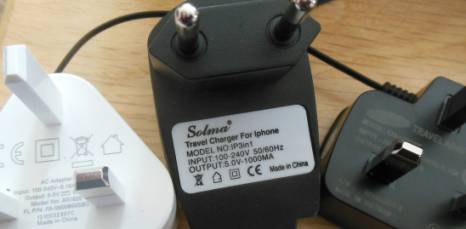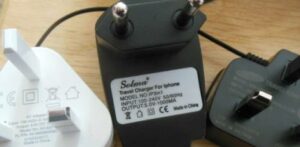Your basket is currently empty!

Phone chargers – drips or leaks?
If you’re looking at reducing your electricity bill lots of people will tell you:
“Unplug your chargers/transformers when not charging items, as they still draw power. These include cell phone, digital camera, battery and cordless hand vacuum/tool chargers.”
This is one of the the ‘easy’ ways lots of people think they can reduce their energy footprint. But how much of a difference will it actually make to your bill?
Writing this article reminded me a little of something I’d read before.
“For example, people worry about leaving disconnected chargers plugged into the wall for fear that they’re draining power. Are they right? You can use heat flow to come up with simple rule of thumb: If an unused charger isn’t warm to the touch, it’s using less than a penny of electricity a day. For a small smartphone charger, if it’s not warm to the touch, it’s using less than a penny a year.”
Now those are US pennys, so multiply them by ten to get Rand-Cents… 10c per year doesn’t sound like much does it. At Homebug we always check the numbers ourselves. So let’s look at how do I find much the chargers around the house cost. Luckily for us EVERY single device that plugs into a socket has to have all the details we need.

We’re focusing today on phone chargers, camera chargers, anything that has a little micro-USB dongle at the end, or just a big flat USB square that you have to plug your specific cable into. You can see an energy rating printed right between the pins on these plug-chargers – we’re looking for two things… Voltage (any number with a ‘V’ after it) and Current (any number with an ‘A’ or ‘mA’ after i)t. We’re then going to multiply these two numbers to get the ‘power’. Your chargers might have two sets of numbers – one called input and one called out. You’ll see as we go through the chargers on the left. Starting on the left we have a white Amazon Kindle charger, in the middle is a cheapie USB-cable charger that came included with some knock-off electronics, and on the right is a Samsung phone charger.
| Kindle Charger | Solma USB | Samsung charger |
| Input: 100-240V @ 0.15A 50/60Hz | Input: 100-240V 50-60Hz | Input: 100-240V-50-60Hz 0.15A |
| Output: 5.0V == 0.85A | Output: 5.0V-1000MA | Output: 5.0V == 0.7A |
We’ll focus here on the Output side — this is the amount of power it can put into the device it’s charging. To use a vehicle analogy, think of the charger like a truck delivering energy to your phone or camera. The first number, the one with a ‘V’ after it, is the voltage — this is like the speed of the truck. The second number — the one with an A or MA after it is the current – think of this as the size of the truck – how much it can carry. We’re trying to work out how much that truck can deliver to us a period of time … so we have to multiply it’s speed by it’s size. So for the Kindle Charger – “Output: 5.0V == 0.85A” – we have 5.0 times 0.85 = 4.25 watts.
Next the middle one – my cheapie Selma USB charger. (It says for Iphone, but it can with some little USB toy!). This one says 5.0V and 1000MA –> we need to convert the 1000 ‘milli-amps’ into Amps –> and just like millimetres to meters or millilitres to Litres, we have to divide the number by 1000. So 1000MA equals 1A. So now our quick calculation: 5V times 1A = 5 Watts. Finally the Samsung charger 5 x 0.7 = 3.5W.
My USB chargers use between 3.5W and 5W of power when they are charging. To put these numbers into perspective 5W on all day (24 hours) is 120 watt-hours –> and there’s 1000 watt-hours in 1 kilo-watt hour or ONE unit of electricity. So one of these chargers, charging a device all day will use just over 0.12 electricity units per day (around 18 cents). Over a month that’s 3.6 electricity units, or around R5 for a whole month of charging.
But how much do they use when they’re not charging? Some have clever electronics inside that switch everything off when nothing’s connected. These tiny amounts of power are too small to measure reliably with Homebug, so I had to use a micro-power-meter. I put each of the chargers in a different plug all of them switched off. Next I turned on one switch – saw how much the power went up, then I connected something to the charger (e.g. a phone with a low battery) to see how much it used charging. As you can see in the table below, the chargers all take in a little more energy than they can deliver into the phone or camera they are charging — some of the energy falls off the back of the truck as it’s being delivered… As you can see below all of the chargers, even the cheaper one, use much less power when they aren’t charging compared with when they are.
Power usage of each charger:
| Kindle Charger | Solma USB | Samsung charger |
| Output: 4.25W | Output: 5.00W | Output: 3.50W |
| Charge: 5.74W | Charge: 7.80W | Charge: 4.55W |
| Idle: 0.11W | Idle: 0.50W | Idle: 0.05W |
These numbers are fine, but they don’t mean anything until I translate them to Rands! To do that I need take the Watts figure and multiply by 24 –> that gives me watt-hours per day. Then I divide that by 1000 to get KiloWatt-hours per day. Finally multiply by how much you pay for electricity (I’ve guessed R1.50/kWh). These numbers are pretty small, so you might want to multiply by 30 to get Rands per month, or by 365 to get cost per year.
Cost of each charger – not charging
| Kindle Charger | Solma USB | Samsung charger |
| Day: under 1c | Day: R0.02 | Day: under 1c |
| Month: R0.12 | Month: R0.54 | Month: R0.04 |
| Year: R1.45 | Year: R6.57 | Year: R0.53 |
To summarise, leaving one of my USB chargers plugged in can cost around R0.50 per month; but can be as low 50c per year! There might be a whole bunch of these chargers plugged in at your house, but if they are modern chargers like the Samsung or Amazon ones above, the savings from unplugging even 10 of them won’t make a dent in your bill.
To put these numbers into context — it’s probably not worth switching on the lights to turn off a charger! If you have a Samsung charger and your room has six 50W downlighters and takes you more than 6 seconds to find and unplug your charger before going to work in the morning, you’ll use more energy finding the charger than you will leaving it plugged in.
- 6 seconds of lights (6 x 50W = 300W x 6 seconds / 3600 seconds in an hour) = 0.50 watt-hours
- 12 hours of charger on idle (0.04W x 12 hours) = 0.48 watt-hours
- (FYI – each of these things cost you less than 1 tenth of a cent… – or around 30c if you did it every day for a year…)
So the moral of this story is — unplugging your phone charger is unlikely to make any noticeable dent in your bill. However, leaving one room of lights (like the example above) for a just one day can cost as much as R10! In order to know where you are using or wasting electricity needs consistent monitoring – minute by minute, 24 hours a day — Homebug makes that easy.
Rather than phone chargers it is probably much better to concentrate on some of the larger ‘phantom’ loads like – your Entertainment Centre: DSTV encoder, TV, DVD, and others…
——————–
For those really into the numbers side of things there’s a good review of different chargers here —> makes me really wonder whether I should throw out that Cheapie Solma charger! And the answer to the question “should I charge from my computer or a separate charger” here.

Leave a Reply